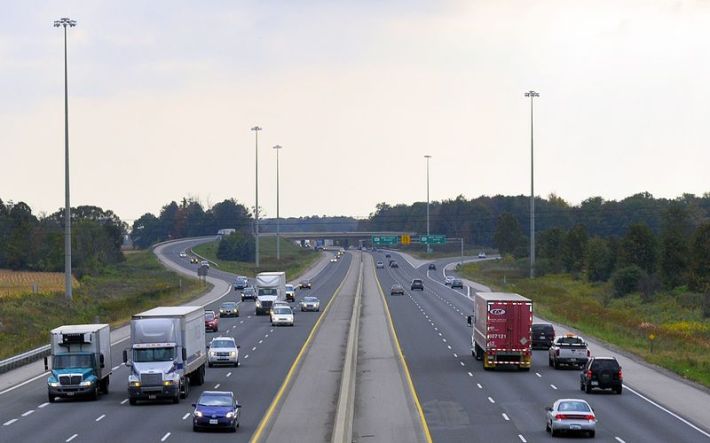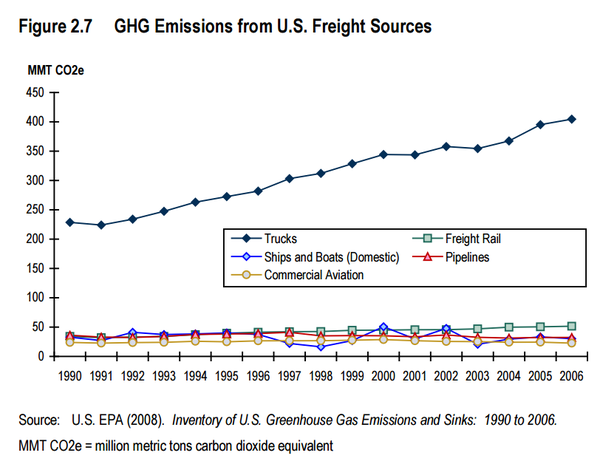
Smart people are wading through the 1,300-page transportation bill that came out of conference committee earlier this week, and we're starting to get a clearer sense of how it will change federal transportation policy for the next five years.
The House voted to pass the bill by an overwhelming margin just moments ago, and President Obama has already pledged to sign it, so it's as good as law at this point.
This bill is not a major shift for federal transportation policy. It's mostly an extension of the status quo funded by some accounting gimmicks. But national advocates for sustainable transportation and safer streets were able to notch a few wins in an adversarial political climate.
In his round-up for Transportation for America, Stephen Lee Davis lists some of the rays of hope:
More support for smart transit-oriented development projectsDue in part to the hard work of T4America, Smart Growth America and LOCUS over the last year, transit-oriented development projects will be eligible for the low-interest TIFIA and RRIF federal financing programs. The small pilot program of TOD planning grants was also preserved; grants that help communities make the best use of land around transit lines and stops, efficiently locate jobs and affordable housing near new transit stations, and boost ridership.
Authorization for passenger rail is in the surface authorization for the first timeWhile the bill does far too little for truly making our system multimodal and making greater investments in more transportation options, it takes a positive step by bringing passenger rail into the larger surface transportation authorization for the first time ever. (This was typically passed as a standalone bill and Congress usually had little impetus for quick action.) Passenger rail will still have to go through the general appropriation process each year (getting started now for FY16, if you’ve been following along) to get their funding, but this positions it well for the long-term hope: including and funding passenger rail with guaranteed funds from a multimodal, 21st century transportation trust fund in the years ahead.
A (slight) increase in funding for metropolitan regionsThough the final product was far short of what we had been pushing for, local governments will receive slightly more money to invest in their priority projects, with an increase in what’s known as suballocated funds by 1 percent per year of the bill, up to 55 percent in 2020. Unfortunately, this bill does nothing to give smaller communities under 200,000 in population any more control over how these funds are spent in their areas — the state will retain authority and can continue to choose to ignore local needs. Overall, funding directed to local communities is an improvement over MAP-21, but the funding and especially the control over those dollars still falls far short of what we need. (More on this below.)
Locals have greater access to low-cost federal loansTo apply for a TIFIA loan today, the total project cost has to be over $50 million, which makes it difficult or impossible for the projects in places that aren’t our biggest metro areas to receive funds. Our colleagues at LOCUS worked with other partners to get the threshold successfully lowered to $10 million, which opens the door to a wider range of project types in communities of all sizes, including complete streets, urban street retrofits, trails and other low-cost projects that are often the highest priority for local communities.
Safer streets for all usersWorking alongside our colleagues at the National Complete Streets Coalition, we were successful in winning the requirement that state DOTs and metropolitan planning organizations (MPOs) consider all users of the roadways when designing and building projects. Further, we were able to include a provision in the bill that allows local governments to use the street design manuals of their preference (like the NACTO guide) and preempt their state DOT’s design manual for locally constructed projects. Far too often, local governments are working hard to develop complete, safe streets, but are stymied by their state DOT’s desire to maintain fast speeds and wide lanes at the expense of other people who need to use the street and would benefit from narrower lanes, safe bike lanes or wider sidewalks.
There are some steps backward too, however, including a big giveaway to the trucking industry.
Even as world leaders meet in Paris and attempt to prevent catastrophic climate change, Congress has crafted a bill that will make America more dependent than ever on one of the dirtiest, most energy-intensive ways to move goods, Davis reports:
Freight moves across the country on every mode of travel imaginable and our freight issues are inherently multimodal, but Congress didn’t see it that way when they earmarked 90 percent of the funds in a new freight program for highway projects. This new combination of a formula and separate discretionary grant program is the first time Congress has funded a freight program in the transportation bill, but unfortunately other options like ports, railroads, intelligent transportation systems, or better demand management are only eligible for a small share of the freight dollars. The bill creates a discretionary grant program with $800 million this year, rising to $1 billion in 2020, and creates a new formula program with $1.15 billion in the first year rising to $1.5 billion in 2020.
The bill requires states and metro areas to analyze their freight movement and come up with a multimodal plan to improve things (good!) but then only gives them funding to build highway solutions (bad!). This is a backdoor way to provide more unaccountable funding to states for highway projects that may have been on the drawing boards for decades, and does little to promote cost-effective solutions to freight mobility. One additional issue is that this new formula program relies on current highway formulas unrelated to freight movement and completely ignores freight tonnage or value that would ensure we get the biggest bang for the buck from these investments.
As Yonah Freemark of Chicago's Metropolitan Council points out, America's dependence on freight trucking is already a disaster for the climate:
Politico reports that the bill also takes a swipe at red-light cameras, which have proven to be an effective tool to reduce severe traffic injuries and fatalities, especially in urban areas:
Congress isn't budging on resistance to red-light cameras. Martine reports that, just as in MAP-21, the multiyear highway and transit bill will prevent states from using federal funds to pay for "automated traffic enforcement systems" that capture traffic light scofflaws or highway speedsters. Still, the new bill will require states paying for their own traffic enforcement tech to conduct biennial surveys on the number and safety effects of all their cameras. From the Governors Highway Safety Association's Kara Macek: "There's an irony there that states are required to study the effectiveness of a program that they're not allowed to implement."






